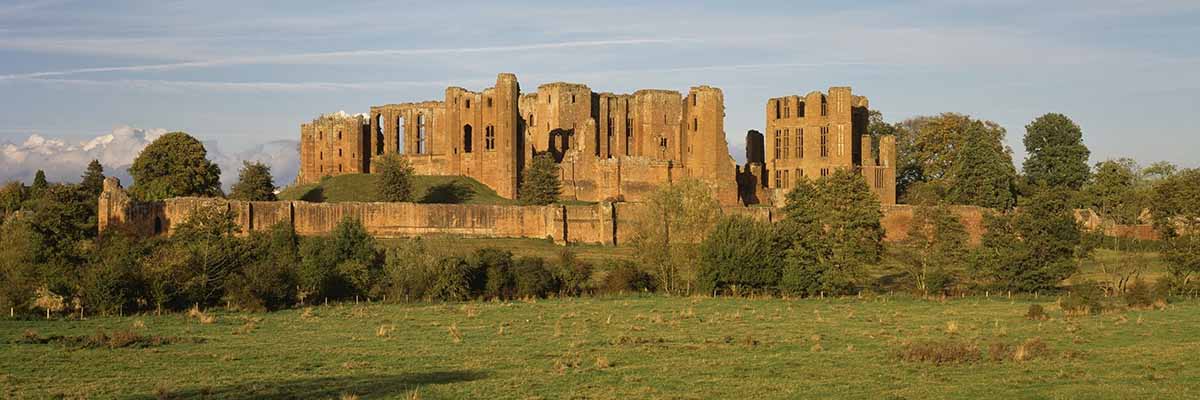Significance of Kenilworth Castle
One of Britain’s foremost historical sites, Kenilworth was a royal castle for much of its history. The outstanding medieval and Renaissance architecture of its buildings bears witness to the roles it has had as fortress, palace, theatrical setting and inspiration to artists of the Romantic era.

Origins
While many medieval lordly estates developed gradually, the defining components of Kenilworth – castle, park, mere and priory – were all created in the 1120s by a single man, Geoffrey de Clinton, the king’s treasurer and chamberlain.[1]
The Siege of Kenilworth
Kenilworth functioned as a military stronghold for a later owner, Simon de Montfort, 6th Earl of Leicester. Following his rebellion against Henry III and death at the Battle of Evesham in August 1265, de Montfort’s supporters retreated here. In 1266, Henry besieged the castle for an extraordinary six months, one of the longest full-scale sieges on English soil. The rebels responded vigorously, cutting off the king’s messenger’s hand and mounting daring sorties. Kenilworth was never taken, and a truce was eventually agreed.[2]
John of Gaunt’s Palace
The work at Kenilworth undertaken from 1370 by John of Gaunt, Edward III’s fourth son, counts as one of the most significant and ambitious building campaigns of the 14th century.[3] He created a suite of apartments conceived according to a coherent architectural programme. Edward III first achieved such unified treatment at Windsor Castle in the 1350s, and Gaunt’s work at Kenilworth represented the start of its transmission elsewhere.[4]
The scale and stylistic sophistication of this palace embodied Gaunt’s princely status and regal aspirations. The remarkable accommodation included service spaces, state rooms, and several further high-status reception rooms. The great hall was the widest roofed space in England after Westminster Hall.
The fact that these buildings, said to represent ‘the finest sweep of semi-royal apartments of the later middle ages to survive in Britain’, served for the next two hundred years with so little alteration is testimony to their precociousness.[5]
The Medieval Landscape
Kenilworth is also remarkable for the scale and splendour of its landscape setting, which was theatrically conceived from the first. The windows of Gaunt’s apartments gave commanding views of the mere and park beyond, while the chase, the hunting ground created by later owner Robert Dudley, was an arena in which a hunting party could bring down beasts in the full view of castle spectators.
Although an extensive man-made landscape around a castle is not unusual, the size of that at Kenilworth is notable. The documentary record shows that by the end of the Middle Ages the parks consisted of well over 1,619 hectares (4,000 acres), and that the mere measured half a mile across, with a great moated retreat (the Pleasance) at the far end. There were water mills, fishponds, rabbit warrens and stone quarries. All these features remain legible in the landscape today.
Elizabethan Kenilworth
As the only surviving house of Robert Dudley (d.1588), Earl of Leicester, Kenilworth offers a unique window on the Elizabethan court. The castle’s extensive remains, together with two detailed accounts by Robert Langham and George Gascoigne, give a strikingly complete picture of the lavish entertainment provided for Elizabeth I during her long stay in 1575. The garden created by Leicester for the queen on this occasion is the best known of the age and has been the subject of two modern attempts at recreation.[6]
Kenilworth also reveals much about Elizabeth I’s favourite. Though young, Leicester hankered after an ancestry that the great Midlands castle represented. He cherished Kenilworth’s antiquity, removing little medieval masonry.
Yet his building work at Kenilworth is also highly significant, and despite his reverence for the past, the architecture was innovative. His new lodging block, Leicester’s Building, though balancing de Clinton’s great tower in design and material, features the thin, brittle walls and large glazed windows that herald the High Elizabethan style of the 1580s and 1590s.
Theatrical Kenilworth
Kenilworth has a long history of representing ancient Englishness. In 1279 the castle hosted a ‘round table’, an Arthurian assembly involving 100 knights in tournaments and festivities. Dudley took Arthurian characters as his theme for his 1575 entertainment, and these associations seem also to have appealed to Henry and Charles as princes of Wales in the early 17th century.
In the 19th century, thanks to Walter Scott’s novel Kenilworth, Dudley and Elizabeth themselves joined the cast. The 1939 Kenilworth Pageant featured 2,000 players performing episodes from Kenilworth’s history, and modern re-enactments continue the tradition.[7]
READ MORE ABOUT KENILWORTH CASTLE
Footnotes
1. D Crouch, ‘Geoffrey de Clinton and Roger, Earl of Warwick: new men and magnates in the reign of Henry I’, Bulletin of the Institute of Historical Research, 55 (1982), 113–24.
2. W Dugdale, The Antiquities of Warwickshire Illustrated: From Records, Leiger-Books, Manuscripts, Charters, Evidences, Tombes, and Armes: Beautified With Maps, Prospects and Portraictures (London, 1656), 162–3.
3. JH Harvey, ‘Side-lights on Kenilworth Castle’, Archaeological Journal, 101 (1944), 95 (accessed 9 August 2014).
4. C Wilson, ‘The royal lodgings of Edward III at Windsor Castle: form, function, representation’, in Windsor: Medieval Archaeology, Art and Architecture of the Thames Valley, ed C Wilson, L Keen and E Scarff, BAA Conference Transactions 25 (Leeds, 2002), 15–94.
5. A Emery, The Greater Medieval Houses of England and Wales 1300–1500, vol 2: East Anglia, Central England and Wales (London, 2000), 399.
6. A Keay and J Watkins (eds), The Elizabethan Garden at Kenilworth (English Heritage, London, 2013).
7. The Times, 17 June 1939.
